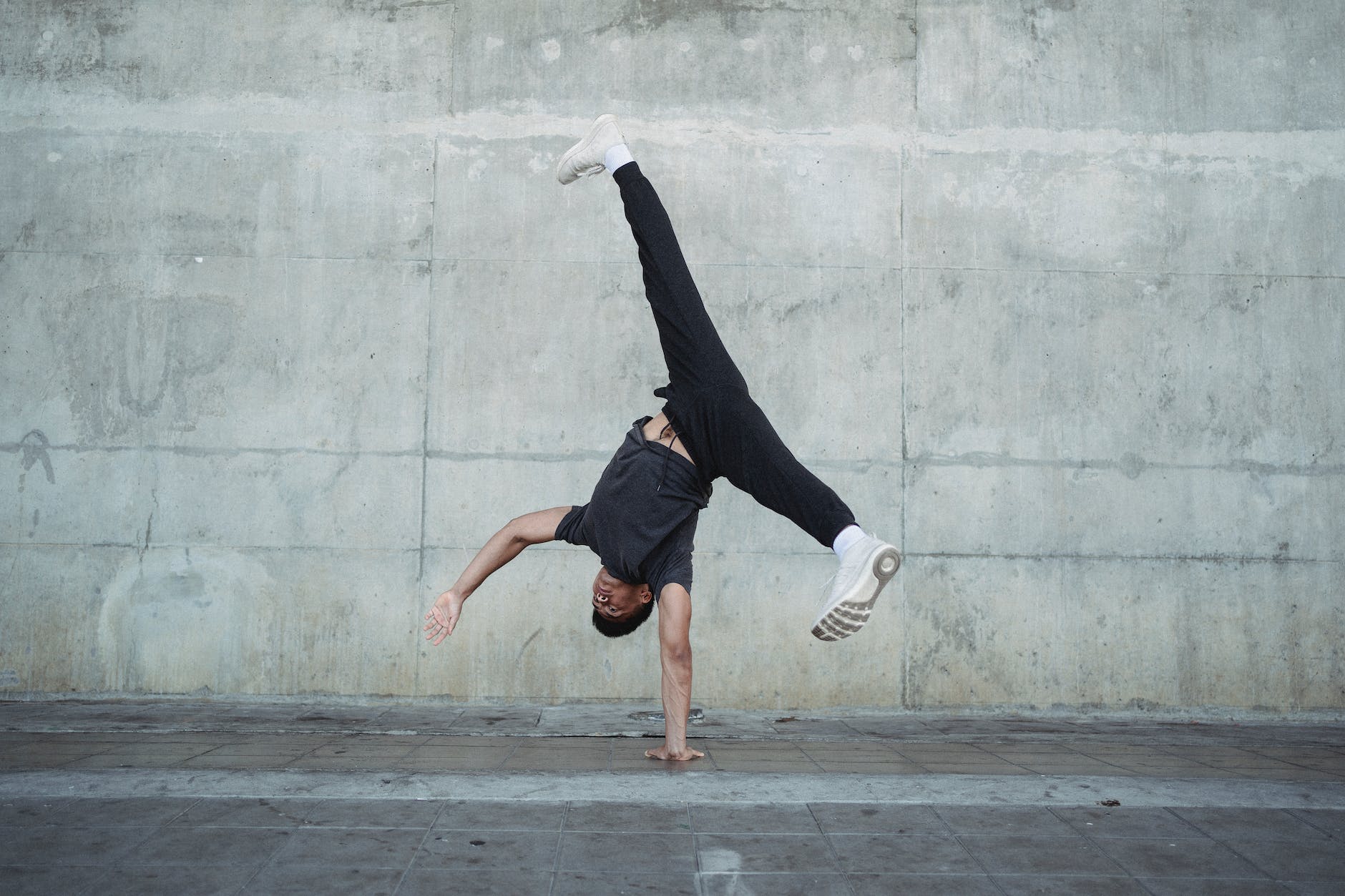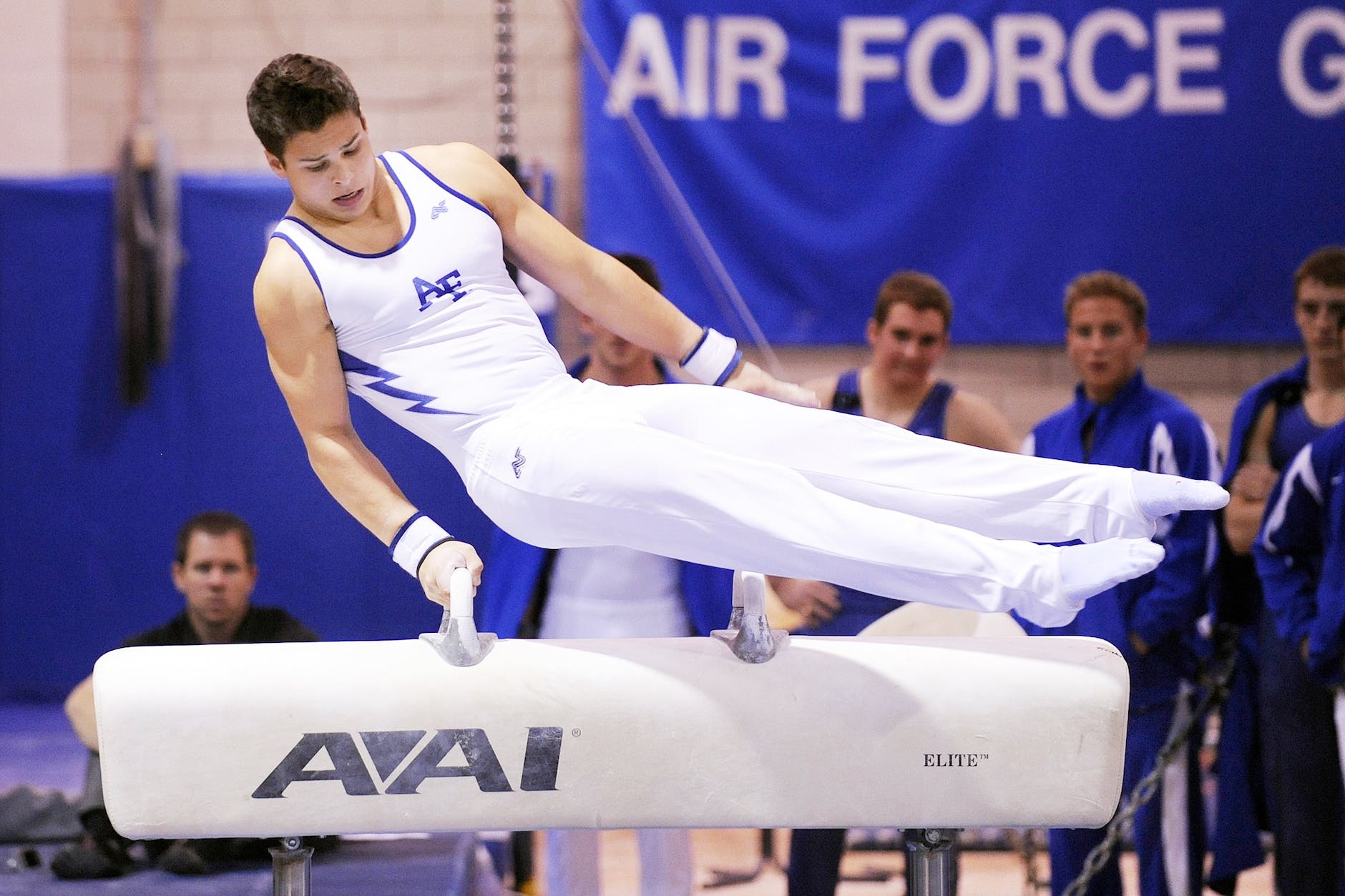Welcome to the thrilling world of breaking, where athletes showcase their unique moves and creativity in intense solo battles!
Breaking involves B-Boys and B-Girls competing in mesmerizing battles using a combination of power moves, freezes, and dance, all synchronized to the beat of DJ tracks.
Let’s dive into the basics of breaking for those new to this electrifying sport.
Table of content:
- Introduction to Breaking
- Objectives of Breaking
- Rules
- Glossary
- Common Tactics & Strategies
- Skills to be a Successful Athlete in Breaking
- Similar Sports to Breaking
1. Introduction to Breaking
- Breaking is a vibrant and dynamic fusion of dance and athleticism that originated from the streets.
- Picture this: B-Boys and B-Girls, the athletes of breaking, step onto the dance floor to engage in thrilling solo battles that showcase their skills and creativity.
- What sets breaking apart are its distinctive moves, ranging from gravity-defying power moves like windmills to striking freezes and spontaneous improvisation synced perfectly to the beats dropped by the DJ.
Breaking, often referred to as b-boying or b-girling, emerged in the 1970s in the South Bronx, New York, as a way for young people to express themselves through dance. Fast forward to today, and it has evolved into a global phenomenon with competitions, events, and a vibrant community that continues to push the boundaries of what is possible in dance.

When you see a B-Boy or B-Girl on the floor, you’re witnessing not just a dance but a form of personal expression. The term “breaking” itself is a nod to the practice of dancers “breaking” away from traditional dance styles and creating something entirely new.
The solo battles in breaking are like intense conversations between dancers, each responding to the other’s moves with their own unique style. The dance floor becomes a canvas, and the B-Boys and B-Girls paint their stories using a combination of athleticism, creativity, and rhythmic precision.
Power moves, characterized by acrobatic spins and flips like windmills and headspins, add an element of awe and spectacle to breaking. Freezes, on the other hand, involve striking poses that demand strength and control, often used to accentuate a particular moment in the dance.
The entire performance is a journey of spontaneity and adaptation as the dancers improvise their moves on the spot, responding to the DJ’s beats and the energy of the moment.
Breaking is not just a dance form; it’s a culture with its own language, where dancers speak through their movements.
From the cypher (a circle where dancers showcase their skills) to the call and response of battles, breaking is a living, breathing art that continues to captivate audiences worldwide.
2. Objectives of Breaking
- Athletes aim to impress judges and secure votes in solo battles.
- Creativity, style, and originality are key components of breaking.
- The ultimate goal is to take home the coveted title of breaking champion.
2.1 Impress the Judges and Secure Votes
In the electrifying world of breaking, solo battles are where B-Boys and B-Girls showcase their skills, striving to leave a lasting impression on the judges.
Judges play a crucial role in determining the winner of a battle, evaluating each dancer’s performance based on factors like execution, musicality, and overall style. It’s not just about executing impressive moves; it’s about doing so with precision, flair, and a unique personal touch that catches the eye of the judges.
Picture a B-Boy executing a flawless windmill, smoothly transitioning into a gravity-defying freeze—all synchronized to the beat. The aim here is not just to execute moves but to tell a story, to communicate through dance and leave the judges nodding in approval.
2.2 Creativity, Style, and Originality
Breaking isn’t just about the technical execution of moves; it’s about showcasing your individuality, creativity, and unique style. B-Boys and B-Girls bring their personalities to the dance floor, infusing each movement with their distinct flair.
Judges appreciate dancers who push the boundaries of creativity, introducing innovative sequences and transitions that set them apart.
Imagine a B-Girl seamlessly blending power moves with graceful footwork, incorporating unexpected freezes and spins. It’s this fusion of technical skill and artistic expression that defines the essence of breaking. Originality is highly valued; dancers are encouraged to bring something new to the table, contributing to the ever-evolving language of breaking.
2.3 The Ultimate Goal: Breaking Champion
Every B-Boy and B-Girl steps onto the dance floor with a dream—the dream of becoming a breaking champion. The title isn’t just a recognition of skill; it’s a symbol of dedication, passion, and the ability to stand out in a fiercely competitive arena.
| Objective | Description |
|---|---|
| Impress the Judges and Secure Votes | B-Boys and B-Girls aim to captivate judges with precise execution, musicality, and a unique personal touch. |
| Creativity, Style, and Originality | Breaking is a canvas for personal expression, where dancers infuse each move with creativity and a distinct style. |
| The Ultimate Goal: Breaking Champion | Winning the coveted title represents dedication, passion, and the ability to stand out in the competitive world of breaking. |
Winning a breaking competition is the culmination of countless hours of practice, honing skills, and pushing personal limits. The journey to the top involves defeats, victories, and an unwavering commitment to the craft.
The breaking champion is not just the best dancer of the day; they embody the spirit of breaking, inspiring others to push their boundaries and elevate the art form.
3. Rules
- Judges evaluate performances based on criteria like execution and musicality.
- Battles consist of rounds, with each athlete showcasing their skills.
- Adherence to established breaking moves and maintaining the rhythm is crucial.
Understanding the rules is essential for any aspiring B-Boy or B-Girl looking to make a mark in the world of breaking.
Here’s a breakdown of the key rules that shape the dynamics of breaking battles:
3.1 Evaluation Criteria
Judges play a central role in determining the outcome of breaking battles. They assess each performance based on specific criteria, with two primary factors standing out: execution and musicality.
Execution: This refers to the precision with which a dancer performs their moves. Clean, well-executed moves leave a lasting impression on the judges. Imagine a B-Boy seamlessly transitioning from a windmill to a freeze with perfect control—that’s top-tier execution.
Musicality: Breaking is not just about the moves; it’s about dancing to the beat. Judges look for dancers who are in sync with the rhythm, using musical accents to enhance their performance. The ability to hit the breaks and pauses in the music demonstrates a deep understanding of musicality.
3.2 Battle Structure
Breaking battles are dynamic and structured affairs, typically consisting of rounds where each athlete gets a chance to shine.

The structure often includes rounds for preliminary showcases, followed by head-to-head battles in later stages.
Preliminary Showcases: B-Boys and B-Girls first showcase their individual skills in preliminary rounds. This is where judges identify the standout performers who will proceed to the head-to-head battles.
Head-to-Head Battles: The heart of breaking competitions lies in the one-on-one battles. Two dancers face off, taking turns to showcase their skills. Judges closely observe how each dancer responds to the other, adding a layer of strategy and spontaneity to the battles.
3.3 Adherence to Breaking Moves and Rhythm
Breaking has a rich vocabulary of moves, each with its own history and style. While dancers are encouraged to bring their creativity, there’s also a foundation of established moves that form the essence of breaking. Adherence to these moves demonstrates a respect for the tradition of breaking.
Moreover, maintaining the rhythm is non-negotiable. The dance is a conversation with the music, and dancers must stay attuned to its beats. Synchronizing moves with the rhythm not only impresses judges but elevates the overall impact of the performance.
Imagine a B-Girl seamlessly transitioning from a footwork sequence to a freeze precisely as the beat drops—that’s the perfect blend of breaking tradition and contemporary flair.
| Rule | Description |
|---|---|
| Evaluation Criteria | Judges assess performances based on execution and musicality. |
| Battle Structure | Breaking competitions consist of preliminary showcases and head-to-head battles. |
| Adherence to Breaking Moves and Rhythm | Dancers must balance creativity with respect for established breaking moves, maintaining synchronization with the rhythm. |
4. Glossary
- Power Moves: Energetic and acrobatic dance moves, e.g., windmills.
- Freezes: Pausing in a dramatic pose to add flair to the performance.
- Improvisation: Adapting moves spontaneously to the DJ’s beats.
Breaking has its own language, a unique glossary that adds depth and meaning to the dance. Let’s dive into some essential breaking expressions that every aspiring B-Boy or B-Girl should know:
- Power Moves: These are the explosive and acrobatic moves that define breaking. Imagine a B-Boy or B-Girl executing windmills, a continuous rotation of the body on the ground. Power moves demand strength, agility, and a fearless approach to the dance floor.
- Freezes: Freezes are iconic moments in breaking where a dancer pauses in a dramatic and visually striking pose. It’s like hitting the pause button in the midst of a dynamic routine, adding flair and emphasis to a particular moment. Picture a B-Boy balancing on one hand, frozen in mid-air—that’s a freeze.
- Improvisation: Breaking is not just about rehearsed routines; it’s about spontaneity and adapting to the music in real-time. Improvisation involves making on-the-spot decisions, responding to the DJ’s beats, and surprising both the audience and the opponent with unexpected moves. It’s the element of surprise that keeps breaking fresh and dynamic.
- Footwork: Footwork is the intricate and rhythmic movement of the feet on the dance floor. B-Boys and B-Girls showcase their agility and creativity through footwork sequences, moving seamlessly from one step to another. It’s like a dance of the feet, adding complexity and style to the overall performance.
- Toprock: Toprock refers to the dance movements performed while standing upright. It’s the initial phase of a breaking routine where the dancer establishes their presence on the dance floor. Toprock is all about style, showcasing individual flair through movements like shuffles, kicks, and spins.
- Downrock: Downrock, also known as floorwork, involves dance movements performed close to the ground. B-Boys and B-Girls transition from standing to the floor, incorporating intricate movements with their hands, legs, and body. Downrock adds depth to the overall routine, highlighting versatility and control.
- Headspin: The headspin is a signature move in breaking, where the dancer spins on their head, showcasing incredible balance and control. It’s a visually stunning and technically demanding move that often takes years of practice to master. Picture a B-Boy defying gravity with a mesmerizing headspin—truly a showstopper.
- Windmill: The windmill is a classic power move in breaking, characterized by a continuous rotation of the body on the ground. Executing a windmill requires a combination of strength, momentum, and precise technique. It’s a move that never fails to captivate audiences with its dynamic and fluid motion.
- Cypher: The cypher is the communal dance space where B-Boys and B-Girls showcase their skills. It’s a circle formed by fellow dancers and enthusiasts, creating an energetic and supportive environment. The cypher is where individual expression shines, and dancers take turns to impress and inspire.
- Battle: Battles are at the heart of breaking competitions, where two dancers face off in a head-to-head showdown. Each dancer strives to outperform the other, responding to moves with their unique style and creativity. Battles are a dynamic exchange of energy and skill, often deciding the ultimate breaking champion.
5. Common Tactics & Strategies
- Athletes strategically incorporate power moves to impress judges.
- Creating a visually appealing and unique routine enhances overall performance.
- Adapting quickly to the opponent’s style is a key tactical skill in breaking.
Breaking is not just about individual moves; it’s a strategic dance form where athletes employ tactics and strategies to gain an edge over their opponents.
Let’s explore some common tactics and strategies that B-Boys and B-Girls use to elevate their performances:
5.1 Strategic Use of Power Moves
Power moves, with their dynamic and acrobatic nature, are attention-grabbers. B-Boys and B-Girls strategically incorporate power moves into their routines to leave a lasting impression on the judges.
Timing is crucial; executing a power move precisely on a musical accent can amplify its impact.
Picture a B-Girl unleashing a series of windmills precisely synced with a powerful beat—it’s a strategic choice that not only showcases skill but also captures the rhythmic essence of breaking.
5.2 Creating Visually Appealing Routines
Breaking is not just about executing moves; it’s about creating a visually captivating story on the dance floor. B-Boys and B-Girls carefully plan and choreograph their routines to ensure a seamless flow of movements.
Each sequence is designed to complement the previous one, creating a visually cohesive and appealing performance. The art lies not only in individual moves but in the overall composition of the routine.
Imagine a B-Boy transitioning effortlessly from footwork to a freeze, each element building on the previous one to tell a compelling visual story.
5.3 Adapting to the Opponent’s Style
Breaking battles are dynamic exchanges where quick thinking and adaptability play a crucial role. B-Boys and B-Girls keenly observe their opponents, identifying their unique style and strengths.
The ability to adapt to the opponent’s moves and respond with counter-moves demonstrates a high level of tactical skill. It’s like a dance chess match, where anticipating the opponent’s next move and countering with creativity can turn the tide of a battle. Picture a B-Boy seamlessly transitioning from downrock footwork to a freeze to counter an opponent’s power move—it’s a tactical dance strategy in action.
In the world of breaking, tactics and strategies are as diverse as the dancers themselves. From surprising the opponent with unexpected moves to building a routine that unfolds like a narrative, every strategic choice contributes to the overall artistry of breaking.
Remember, breaking is a constant evolution. The tactics that worked yesterday may not work tomorrow. Successful B-Boys and B-Girls are those who stay innovative, constantly pushing the boundaries of what’s possible in dance.
5.4 Tactical Innovation and Evolution
Breaking is an ever-evolving art form, and successful dancers understand the importance of innovation.
Tactics that were groundbreaking in the past may become commonplace, prompting B-Boys and B-Girls to invent new moves and strategies to stay ahead of the curve.
The willingness to take risks, experiment with new combinations, and bring a fresh perspective to breaking is a hallmark of the most respected dancers in the community.
5.5 Mental Preparation
Beyond the physical aspect, breaking requires mental fortitude.
Successful athletes engage in mental preparation to stay focused and composed during battles. Visualization, mindfulness, and maintaining a positive mindset contribute to the mental resilience needed to navigate the intensity of breaking competitions.
| Tactic/Strategy | Description |
|---|---|
| Strategic Use of Power Moves | B-Boys and B-Girls strategically incorporate dynamic power moves to leave a lasting impression on judges. |
| Creating Visually Appealing Routines | Breaking athletes carefully plan routines for a seamless flow of movements, creating visually captivating performances. |
| Adapting to the Opponent’s Style | Quick thinking and adaptability are key as dancers observe and respond to the unique style and moves of their opponents. |
| Tactical Innovation and Evolution | Successful B-Boys and B-Girls continually innovate, inventing new moves and strategies to stay ahead in the ever-evolving world of breaking. |
| Mental Preparation | Beyond physical skills, mental preparation is crucial for maintaining focus and composure during intense breaking battles. |
6. Skills to be a Successful Athlete in Breaking
- Technical Proficiency: Mastering fundamental breaking moves and techniques.
- Creativity: Showcasing original and inventive dance sequences.
- Adaptability: Quickly adjusting moves based on the rhythm and opponent’s style.
Becoming a successful athlete in breaking requires a unique blend of technical prowess, creativity, and adaptability. Let’s delve into the essential skills that set the best B-Boys and B-Girls apart:
6.1 Technical Proficiency
Technical proficiency forms the backbone of breaking.
Athletes must master the fundamental breaking moves and techniques that define the dance form. This includes a deep understanding of power moves like windmills, freezes, footwork, and transitions between them.
Each move demands precision, control, and the ability to execute with flair. Developing technical proficiency is a continuous journey of practice, refinement, and dedication to the craft.
Imagine a B-Boy seamlessly transitioning from intricate footwork to a gravity-defying freeze, each move executed with technical precision. It’s this mastery of the fundamentals that lays the foundation for a standout breaking performance.
6.2 Creativity
Breaking is not just a set of prescribed moves; it’s an art form that thrives on individual expression and creativity.
Successful athletes showcase their unique style and personality through original and inventive dance sequences. Creativity in breaking involves experimenting with different movements, adding personal flair to traditional moves, and surprising audiences with unexpected transitions.
Picture a B-Girl seamlessly integrating a classic windmill with a modern twist or a B-Boy introducing a new freeze that becomes a signature move—this is the essence of creativity in breaking.
Creativity is the soul of breaking, allowing athletes to contribute to the evolution of the dance form and leave an indelible mark on the breaking community.
6.3 Adaptability
The ability to adapt is a hallmark of successful B-Boys and B-Girls.
Breaking battles are dynamic, and opponents often have different styles and approaches. Athletes must quickly adjust their moves based on the rhythm of the music and the unique style of their opponent.
Adaptability in breaking involves reading the dance floor, anticipating the opponent’s next move, and responding with agility and creativity.
Whether it’s seamlessly transitioning from footwork to a freeze or adjusting the pace to match the DJ’s beats, adaptability is a key skill that ensures a dancer remains versatile and effective in battles.
Imagine a breaking battle where a B-Boy responds to an opponent’s power move with a swift and unexpected counter-move, perfectly synchronized with the music. This ability to adapt not only impresses judges but also adds an element of surprise to the performance.
| Skill | Description |
|---|---|
| Technical Proficiency | Athletes must master fundamental breaking moves, including power moves, freezes, and footwork, with precision and control. |
| Creativity | Breaking is an art form that thrives on creativity, with successful athletes showcasing original and inventive dance sequences. |
| Adaptability | The ability to quickly adjust moves based on the rhythm and opponent’s style is crucial for success in breaking battles. |
7. Similar Sports to Breaking
While breaking holds a unique place in the world of dance and athleticism, there are several other sports that share certain similarities in terms of individual expression, creativity, and dynamic performances.
Let’s explore five different sports that, while diverse, share common threads with breaking:
7.1 Gymnastics
Gymnastics is a sport that combines strength, flexibility, and artistic expression.
Much like breaking, gymnasts perform routines that involve a series of dynamic and precise movements. Floor exercises in artistic gymnastics, for instance, showcase elements of dance, acrobatics, and flexibility.

Athletes in both gymnastics and breaking need to master their moves, execute them with precision, and infuse their performances with a touch of personal flair.
The floor routine of a gymnast can be likened to the individual expression showcased in a breaking battle.
7.2 Figure Skating
Figure skating, especially in its freestyle form, shares parallels with breaking in terms of individual expression and creativity.
Figure skaters perform choreographed routines to music, incorporating spins, jumps, and intricate footwork. The emphasis on artistic interpretation and storytelling through movement is a common thread.
Like B-Boys and B-Girls, figure skaters aim to captivate judges with a unique blend of technical skill and creative expression, making each performance a personal journey on the ice.
7.3 Skateboarding
Skateboarding, with its roots in street culture, is another sport that resonates with the spirit of breaking. Both involve a deep connection to urban culture, self-expression, and pushing the boundaries of what is possible.
Skateboarders, like B-Boys and B-Girls, bring their own style to the sport, incorporating tricks, flips, and slides to create a visual and dynamic performance. The skatepark, much like the breaking cypher, becomes a canvas for individual expression and creativity.
7.4 Parkour
Parkour, often referred to as the art of movement, shares a certain raw athleticism with breaking.
Parkour practitioners navigate urban environments with fluidity, utilizing a combination of jumps, climbs, and acrobatics.

While breaking is deeply rooted in dance, both breaking and parkour require a mastery of body movements and a sense of creativity in adapting to the surrounding environment.
The improvisational nature of parkour resonates with the spontaneity seen in breaking battles.
7.5 Capoeira
Capoeira, an Afro-Brazilian martial art, combines elements of dance, acrobatics, and music. Much like breaking, it involves a dialogue of movement where practitioners engage in fluid, rhythmic exchanges. The combination of kicks, spins, and ground movements in capoeira bears similarities to the diverse range of movements seen in breaking. Both capoeira and breaking emphasize not just physical skill but also a deep connection to culture and individual expression.
While breaking remains a distinctive and vibrant art form, exploring other sports with common threads sheds light on the diverse ways athletes express themselves through movement, creativity, and a commitment to pushing the boundaries of what is possible.
8. Conclusion and FAQs
In conclusion, breaking is a captivating blend of dance, athleticism, and creativity that takes center stage in solo battles. Now, let’s address some common questions about breaking:
1. What makes a breaking performance stand out?
A standout breaking performance combines technical mastery, creativity, and a unique style, capturing the attention of judges and spectators alike.
2. How is breaking judged in competitions?
Judges evaluate breaking based on criteria such as execution, originality, style, and how well athletes adapt to the music and their opponents.
3. Can anyone participate in breaking competitions?
Breaking welcomes participants of all skill levels, encouraging a diverse community of dancers to showcase their talent and passion in competitions.
4. Are there specific rules for the DJ’s tracks in breaking battles?
While there are no strict rules for DJ tracks, the rhythm and beats play a crucial role, influencing the flow and creativity of an athlete’s performance.
5. How has breaking evolved since its debut in the Youth Olympic Games?
Breaking’s inclusion in the Youth Olympic Games paved the way for its recognition, leading to its exciting presence in the Paris 2024 Olympic sports program.